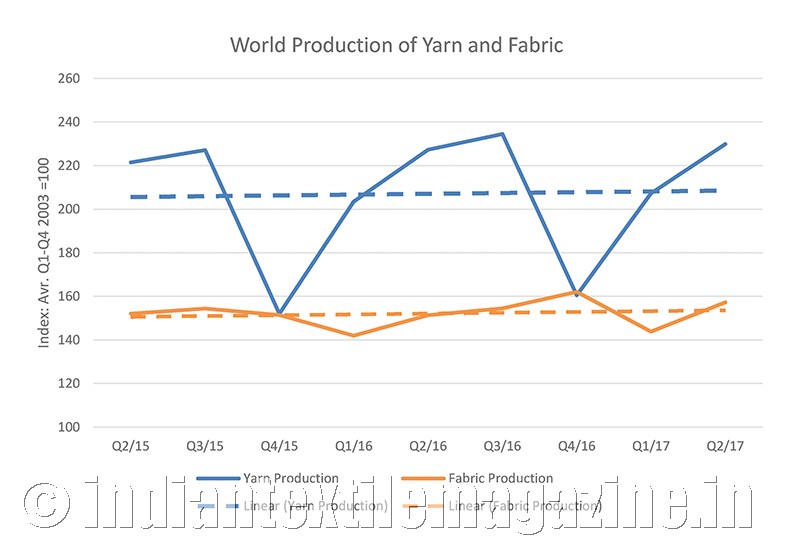The global yarn production improved in the second quarter of 2017. It increased in Asia, Europe and Brazil and slightly declined in the US. The combined effect brings the global yarn production to a level slightly higher than the same quarter of 2016.
The apparent stability of global yarn stocks between the first and second quarters of 2017 is the composite result of a strong increase in Brazil and a strong decrease in Egypt. Global yarn stocks have also improved compared to the same quarter a year earlier. Global yarn orders fell in all regions in the second quarter of the year.
Global fabric production increased in the second quarter of 2017. The output in Asia, Africa and Brazil improved while it was stable in the US and Europe. In the second quarter, worldwide fabric stocks slightly increased, with the most significant change observed in Brazil for the second quarter in a row.
Fabric stocks, however, haven’t reached their Q2/16 level yet. Asian and European fabric orders remained stable in Q2/17 and rose in Brazil and Africa. In comparison to the second quarter of last year, the Asian and Brazilian fabric orders declined significantly, while slightly increasing in Europe and Africa.
For Q3/17, estimates indicate a stable trend in both global yarn and fabric production. For Q4/17, the global outlook for both yarn production and fabric output signal further rise.
In Q2/17, global yarn production rose by 11%, a lower rate of growth compared to the last quarter. The drivers of the Q2/17 growth level are Asia and Brazil with their respective 12% and 11% increases. Yarn production has decreased by 10% in the US and 18% in Africa since Q1/17.
Global fabric production improved by almost 9% in Q2/17, with the most significant increase in Brazil, Asia and Africa (10.4%, 9.8% and 9.2% respectively). The situation has improved compared to Q2/2016 with an increase in the global fabric output of almost 4%.
Global yarn stocks decreased by 1% in Q2/17. Asia, Europe and Brazil saw their yarn inventories increase by 0.7%, 2.3% and 11.5% respectively, but the world average is driven down by a 12% decrease in yarn stocks in Egypt. The stocks improvement of 13% in comparison to Q2/16 is a composite effect of relatively slight variations in Europe and Asia (-3% and +10%), a sharp decrease of nearly 40% in Brazil and a strong increase of 112% in Egypt.
Worldwide fabric stocks rose by 3.3% in Q2/2017. Brazil reported a strong increase of 23%, while variations in all other regions ranged within the +/- 3% margin. Global fabric inventories in Q2/17 decreased by 8% compared to Q2/16. The strongest decrease is observed in Brazil (-30%). Asia and the US are fairly stable and Europe’s stocks moved up by 7%.
In Q2/17, European yarn orders decreased by almost 7%. Reductions of 6% and 4% were recorded in Brazil and Asia respectively. Compared to Q2/16, yarn orders in Europe were stable. They decreased in Brazil and Asia by 17% and 14% respectively.
The 9% increase in global fabric orders in Q2/17 is driven by Brazil and Egypt (+13% and +16% respectively). During the quarter, fabric orders have been stable in Asia and slightly decreased in Europe. They, however, show a relatively strong decrease with respect to the same quarter a year before (21%). This is mainly due to falling orders in Brazil and Asia (-27% and -17%).
